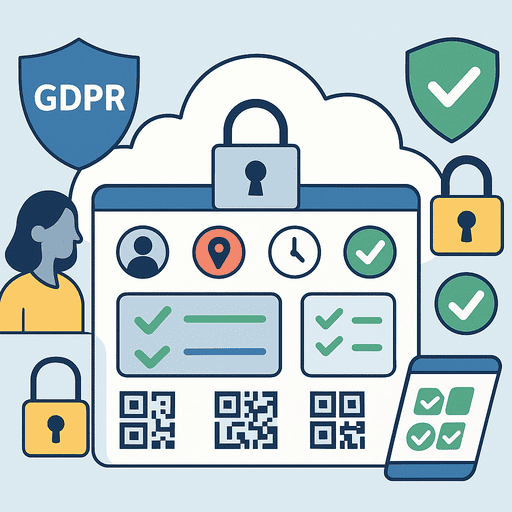GDPR and Asset Metadata: What You Can’t Store
Understand GDPR implications for asset metadata — what personal data you can and can’t store in your inventory system to stay compliant.

Introduction
Most asset tracking systems store more than just item names and serial numbers.
They hold user IDs, assignment history, geolocation, and usage metadata — all of which can become personal data under the General Data Protection Regulation (GDPR).
Mismanaging these details can lead to serious compliance issues, even if you never directly store names or emails.
In this guide, we’ll clarify what counts as personal data, what asset metadata is restricted, and how to handle compliance safely in your inventory or asset management system.
1. Understanding Asset Metadata
Asset metadata refers to any additional data associated with an asset beyond its core description. Examples include:
- User assignments (who used it and when)
- Location tracking (where it is or was)
- Maintenance logs (who performed the task)
- Device identifiers (IMEI, MAC address)
- Audit timestamps (when and by whom verified)
While these fields help with accountability and traceability, they can easily overlap with personally identifiable information (PII) under GDPR.
2. When Metadata Becomes Personal Data
Under GDPR, personal data is any information that can directly or indirectly identify a person.
Even if a field doesn’t contain a name, it might still qualify as PII when combined with other records.
| Metadata Example | GDPR Risk | Why It Matters |
|---|---|---|
| User ID or Employee ID | High | Can identify an individual internally |
| Device serial number | Medium | May link to an assigned user |
| Geolocation / GPS data | High | Tracks individual movement |
| Access logs | Medium | Reveals user behavior patterns |
| IP address or MAC address | High | Considered personal data under GDPR |
| Timestamps with context | Medium | Can reveal working hours or habits |
3. GDPR Principles for Asset Metadata
To stay compliant, your system design must follow these six key GDPR principles:
- Data Minimization — Collect only data necessary for the purpose.
- Purpose Limitation — Use data strictly for inventory tracking, not unrelated analytics.
- Storage Limitation — Define how long audit and assignment data are kept.
- Accuracy — Keep metadata up to date; purge outdated user links.
- Integrity and Confidentiality — Secure all metadata at rest and in transit.
- Accountability — Document and justify every personal data field collected.
4. What You Can’t (or Shouldn’t) Store
Certain metadata fields can expose you to GDPR non-compliance if handled incorrectly. Avoid storing or over-retaining the following:
| Category | Examples | Safer Alternative |
|---|---|---|
| Direct Identifiers | Full names, emails, phone numbers | Use employee ID references |
| Location Tracking | GPS logs, IP traces | Store general site or facility only |
| Sensitive Personal Data | Health info, biometric markers | Never store in asset metadata |
| Behavioral Data | Usage frequency per user | Use anonymized utilization stats |
| Access History Without Consent | Unlogged scans or location updates | Require opt-in or legal basis |
| Personal Notes | Comments identifying colleagues | Prohibit in text fields |
GDPR focuses not only on what’s collected, but also on why and for how long it’s stored.
5. How to Handle User Assignments Safely
It’s common to link assets to employees — laptops, badges, or phones — but it must be done carefully.
Best Practices:
- Store only the user ID, not full identity details.
- Keep history logs for minimal retention periods (e.g., 12–24 months).
- Automatically unlink users from retired or reassigned devices.
- Provide clear employee privacy notices explaining what data is tracked.
- Anonymize past audit records once the relationship ends.
This ensures operational accountability without violating privacy rules.
6. Anonymization and Pseudonymization
To make asset metadata GDPR-safe, apply anonymization or pseudonymization where possible:
| Technique | Description | Use Case |
|---|---|---|
| Anonymization | Irreversibly removes personal identifiers | Archived audit logs |
| Pseudonymization | Replaces identifiers with coded references | Active user-device links |
| Data Masking | Hides data from unauthorized users | Reports and exports |
These techniques maintain functionality (like analytics or audits) while minimizing personal exposure.
7. Data Retention and Deletion Policies
Every organization should define how long metadata is stored and when it’s purged.
| Data Type | Recommended Retention |
|---|---|
| Audit logs | 12–24 months |
| Assignment history | Until reassignment + 6 months |
| Maintenance records | Asset lifespan only |
| Location metadata | 3–6 months max |
Always communicate retention rules clearly in your internal data protection policy.
8. Security and Access Controls
Beyond what you store, GDPR also evaluates how you protect it.
Follow these security measures:
- Encrypt databases and backups
- Restrict access to authorized roles only
- Log and review access regularly
- Apply two-person approval for data exports
- Ensure all third-party integrations (e.g., storage or analytics) are GDPR-compliant
Even compliant data can become risky if security is weak.
Conclusion
Asset metadata might seem harmless, but under GDPR, even small details can identify individuals.
By minimizing personal fields, anonymizing records, and enforcing strict retention and access rules, organizations can balance accountability with privacy — ensuring full compliance and user trust.
Learn more about compliance and data protection: